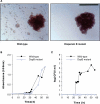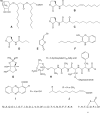Biofilm dispersal: mechanisms, clinical implications, and potential therapeutic uses
- PMID: 20139339
- PMCID: PMC3318030
- DOI: 10.1177/0022034509359403
Biofilm dispersal: mechanisms, clinical implications, and potential therapeutic uses
Abstract
Like all sessile organisms, surface-attached communities of bacteria known as biofilms must release and disperse cells into the environment to colonize new sites. For many pathogenic bacteria, biofilm dispersal plays an important role in the transmission of bacteria from environmental reservoirs to human hosts, in horizontal and vertical cross-host transmission, and in the exacerbation and spread of infection within a host. The molecular mechanisms of bacterial biofilm dispersal are only beginning to be elucidated. Biofilm dispersal is a promising area of research that may lead to the development of novel agents that inhibit biofilm formation or promote biofilm cell detachment. Such agents may be useful for the prevention and treatment of biofilms in a variety of industrial and clinical settings. This review describes the current status of research on biofilm dispersal, with an emphasis on studies aimed to characterize dispersal mechanisms, and to identify environmental cues and inter- and intracellular signals that regulate the dispersal process. The clinical implications of biofilm dispersal and the potential therapeutic applications of some of the most recent findings will also be discussed.
Figures




References
-
- Adair CG, Gorman SP, Feron BM, Byers LM, Jones DS, Goldsmith CE, et al. (1999). Implications of endotracheal tube biofilm for ventilator-associated pneumonia. Intensive Care Med 25:1072-1076 - PubMed
-
- Alipour M, Suntres ZE, Omri A. (2009). Importance of DNase and alginate lyase for enhancing free and liposome encapsulated aminoglycoside activity against Pseudomonas aeruginosa. J Antimicrob Chemother 64:317-325 - PubMed
-
- Alkawash MA, Soothill JS, Schiller NL. (2006). Alginate lyase enhances antibiotic killing of mucoid Pseudomonas aeruginosa in biofilms. APMIS 114:131-138 - PubMed
-
- Allesen-Holm M, Barken KB, Yang L, Klausen M, Webb JS, Kjelleberg S, et al. (2006). A characterization of DNA release in Pseudomonas aeruginosa cultures and biofilms. Mol Microbiol 59:1114-1128 - PubMed
Publication types
MeSH terms
Substances
LinkOut - more resources
Full Text Sources
Other Literature Sources
Medical

